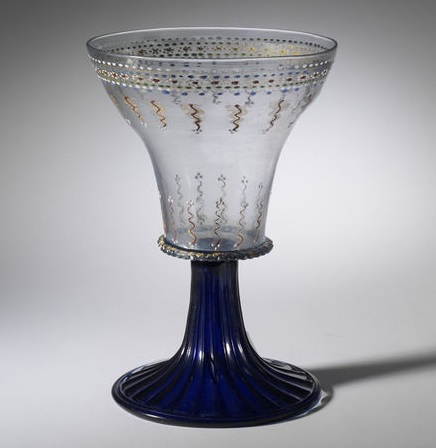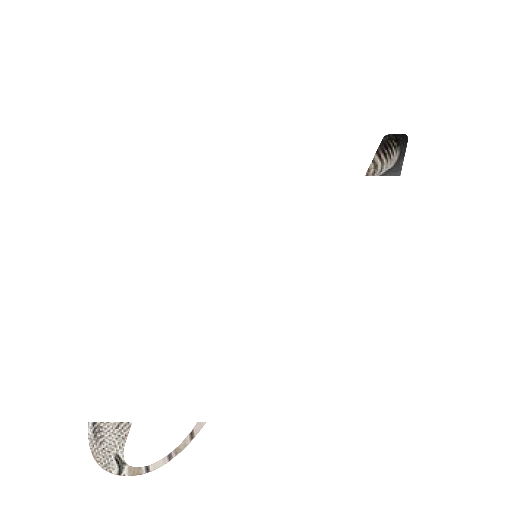Murano glass is glass made on the Venetian island of Murano, which has specialized in fancy glasswares for centuries. Murano’s glassmakers led Europe for centuries, developing or refining many technologies including crystalline glass, enamelled glass (smalto), glass with threads of gold (aventurine), multicolored glass (millefiori), milk glass (lattimo), and imitation gemstones made of glass. Today, the artisans of Murano are still employing these centuries-old techniques, crafting everything from contemporary art glass and glass figurines to Murano glass chandeliers and wine stoppers, as well as tourist souvenirs.
Today, Murano is home to a vast number of factories and a few individual artists' studios making all manner of glass objects from mass marketed stemware to original sculpture. The Museo del Vetro (Glass Museum) in the Palazzo Giustinian houses displays on the history of glassmaking as well as glass samples ranging from Egyptian times through the present day.
Located 1.5 km (0.93 mi) from the main city Venice, Italy, Murano has been a commercial port since as far back as the 7ᵗʰ century. It is believed that glassmaking in Murano originated in 8ᵗʰ century Rome, with significant Asian and Muslim influences, as Venice was a major trading port. Murano glass is similar to the 1ˢᵗ century BC Greek glasses found in the shipwreck of Antikythera. Murano’s reputation as a center for glassmaking was born when the Venetian Republic, fearing fire and destruction of the city’s mostly wooden buildings, ordered glassmakers to move their foundries to Murano in 1291. Murano glass is the largest proportion of Venetian glass.
Murano's glassmakers were soon the island’s most prominent citizens. By the 14ᵗʰ century, glassmakers were allowed to wear swords, enjoyed immunity from prosecution by the Venetian state, and their daughters permitted to marry into Venice’s most affluent families. Marriage between glass master and the daughter of the nobleman wasn't regarded as misalliance. However glassmakers were not allowed to leave the Republic. Exportation of professional secret was punished by death. Many craftsmen took this risk and set up glass furnaces in surrounding cities and as far afield as England and the Netherlands. By the end of the 16ᵗʰ century, three thousand of Murano island's seven thousand inhabitants were involved in some way in the glassmaking industry. French revolutionary armies occupied Murano in 1797.
Murano glass was produced in great quantities in the 1950s and 1960s for export and for tourists
In the 18ᵗʰ century Murano glassmakers started to introduce new products such as glass mirrors and chandeliers to their production. In history these glass chandeliers became popular after the iron, wood and brass era of chandeliers, and they were such a success that instantly brought chandeliers to a new dimension. The first Murano glass chandeliers to be produced by Venetian glassmakers date back around the year 1700. This new type of chandelier was called "ciocca", literally bouquet of flowers, for the characteristic decorations of glazed polychrome flowers. The most sumptuous of them consisted of a metal frame covered with small elements in blown glass, transparent or colored, with decorations of flowers, fruits and leaves, while simpler model had arms made with a unique piece of glass. Their shape was inspired by an original architectural concept: the space on the inside is left almost empty since decorations are spread all around the central support, distanced from it by the length of the arms. One of the common use of the huge Murano Chandeliers was the interior lighting of theatres and rooms in important palaces.
Giuseppe Briati was the most famous producer of these chandeliers. He focused his work on the creation of what are now recognised as the typical Murano chandeliers with multiple arms decorated with garlands, flowers and leaves, called "ciocche". Born on the island of Murano in 1686 from a family of glassmakers he apparently had the chance to work in a Bohemian glass factory, where he learned the secrets of working the crystal, that at the time was taking over venetian glass leadership on the European market. Briati contributed significantly to improve the fortunes of the Venetian glass, which after having experienced a period of success, was heavily decayed. His furnace became famous for the production of Bohemian inspired glass with a twist of eccentricity, that through colors and decorations gave them the look of triumph of polychrome flowers. Giuseppe Briati created what it's now called Rezzonico Chandelier, whose name derive from the first chandelier of its kind, that represents the classic Murano chandelier. It was designed by Briati for the noble venetian family Rezzonico and hung in their palace along the Grand Canal, now famed venetian museum under the name "Ca' Rezzonico". This kind of chandelier, completely realized by hand, required a particular working by the glassmakers due to the arms being formed by many small pieces of glass. Every shape of glass had to be masterly executed because any outsize piece wouldn't fit to be mounted between the others. Rezzonico chandelier is an example of the ability of the Italian craftmanship to adapt to changes and to offer new and innovative solutions to the mutation of architectural needs.
Murano glass chandeliers have a unique history and continue to be produced in Venice today, thanks to the success that makes them one of Venetian glass best-known and most appreciated products. These pretty and joyful glass chandeliers that became popular after the iron, wood and brass era of chandeliers, instantly brings a new dimension of fun and fashion to the idea of chandelier. Today they are widely appreciated as one of the most beautiful and decorative types of chandelier.
Conditioned by the gusto of recovery and revival which had decreed the nineteenth century re-launching, modern glass-making on Murano was born relatively late on, that is, in the first years of the century while it gave original results only in the second decade at the time when the great foreign Art Nouveau glass-makers had already given their best works.
In the first twenty years of this century the glass of modern style was produced at Murano quite discontinuously, for the most part on the occasion of the Venice Biennale exhibitions and of the Fondazione Bevilacqua la Masa at Ca’ Pesaro. Only in the immediate post-war period did the factories begin a normal production of non-traditional models which often constituted the development of attempts made in previous years. In the 1920s Muranese glass-making positively felt the changes which had taken place in the international artistic world to a greater extent than had been the case in the pre-war period. In the 1930s and 1940s we have the happy union to Art Deco, with its preciosity and decorative fancies. The handicraft of production which will continue to characterize the Muranese glass-works in the 30’s and 40’s in such a way that at the dour Biennale of 1942, invaded by praise of war, the Murano glass constituted a vivacious and almost anachronistic note. Having come out from the nightmare of the dictatorship and the war, those who operated in the interior decorating sector took up activity once again with enthusiasm, nevertheless showing themselves divided between the desire to renew themselves on the bases of rationalist principles and the continuous and inevitable reference to the experiences of the 1930s.
The modern furniture market was covered almost completely by Swedish production for the whole of the 1950s. The rationalists produced furnishing objects which were practical and simple, even programmatically modest. The rationalist instances were generally ignored in Murano, while the attempt was made to stylistically renew the product. In this way the glass-makers, exploiting traditional manual techniques, shaped vases in elementary forms, often square, in bright and provocative colors, with schematic motifs, sometimes geometrical whilst others were inspired by abstract painting. This was an exasperated and provocative affirmation of modernity which, shortly after, would be resolved in more meditated ways.
Some of Murano's historical glass factories remain well known brands today, amongst them De Biasi, Gabbiani, Venini, Salviati, Barovier & Toso, Pauly, Berengo Studio, Seguso, Formia International, Simone Cenedese, Alessandro Mandruzzato, Vetreria Ducale, Estevan Rossetto 1950 and many others. The oldest glass factory is Antica Vetreria Fratelli Toso, founded in 1854.
Overall, the industry has been shrinking as demand has waned. Imitation works (easily recognizable by experts but not by the common client) from Asia and Eastern Europe take an estimated 40% - 45% of the market for Murano glass, and public tastes have changed while the designs in Murano have largely stayed the same. Due to these factors, as well as the difficult and low-paying nature of the work, the number of professional glassmakers in Murano has decreased from about 6000 in 1990 to fewer than 1000 today.
In an effort to curb imitations, a collection of companies and concerned individuals in Murano created a trademark to certify authenticity. Today about 50 companies use the Artistic Glass Murano® trademark of origin. The trademark was introduced by and continues to be regulated by Region of Veneto Law no.70 of the 23/12/1994. Factories on the island are not required to apply for the trademark and many choose not to, but if a work carries the trademark, its authenticity is guaranteed.
A VENETIAN GLASS DISH
Venice (c1475-c1525)
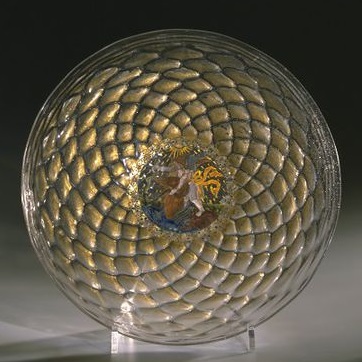
A VENETIAN GLASS PILGRIM BOTTLE
Murano (c1880)
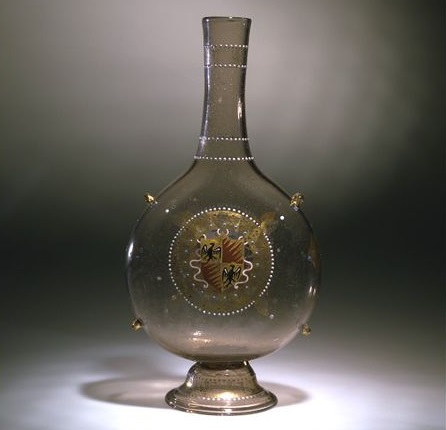
A VENETIAN GLASS DISH
Venice (c1500-c1515)
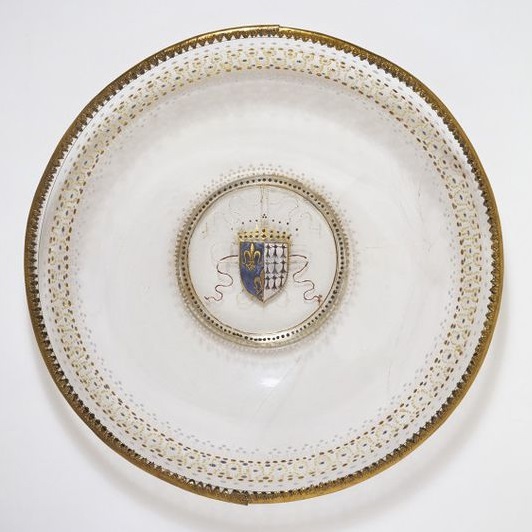
A VENETIAN GLASS BEAKER AND COVER
Venice (c1565-c1570)
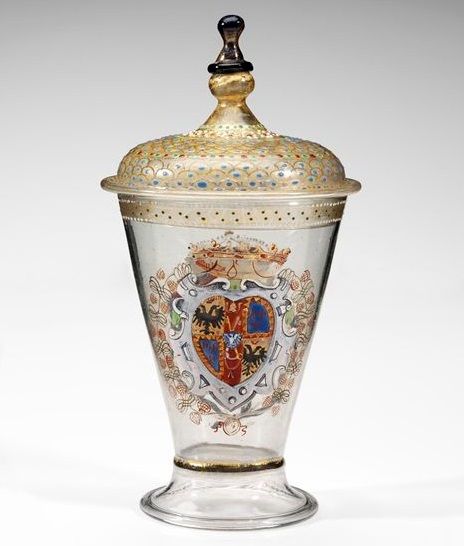
A VENETIAN GLASS VASE AND COVER
Venice (c1475-c1525)
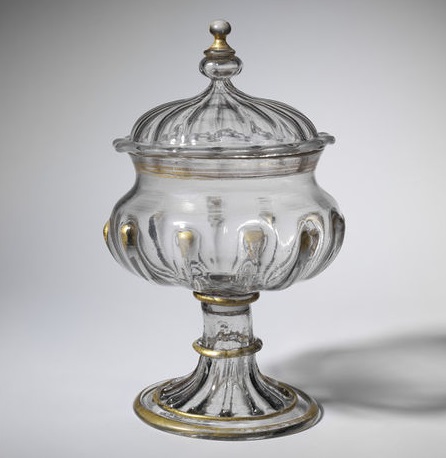
A VENETIAN GLASS GOBLET AND COVER
Venice (c1475-c1500)
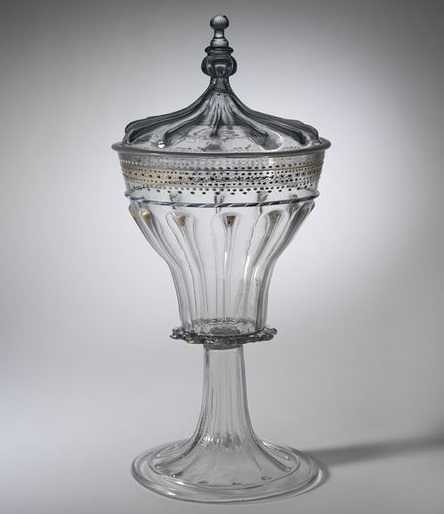
A VENETIAN GLASS TAZZA
Venice (c1500-c1550)
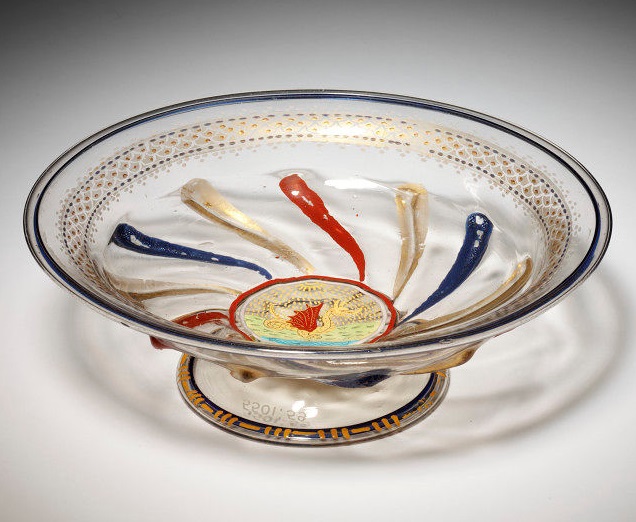
A VENETIAN GLASS STANDING CUP AND COVER
Murano (c1860)
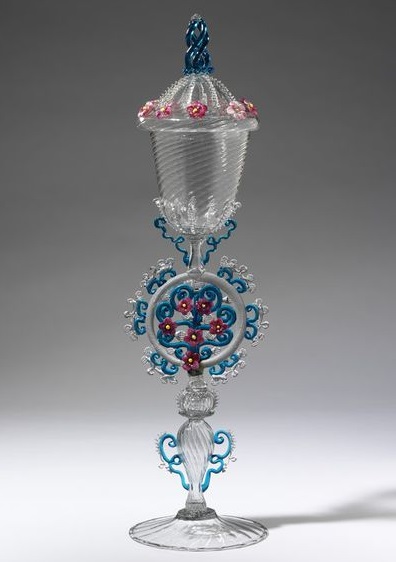
A VENETIAN GLASS GOBLET
Venice (c1500-c1520)
